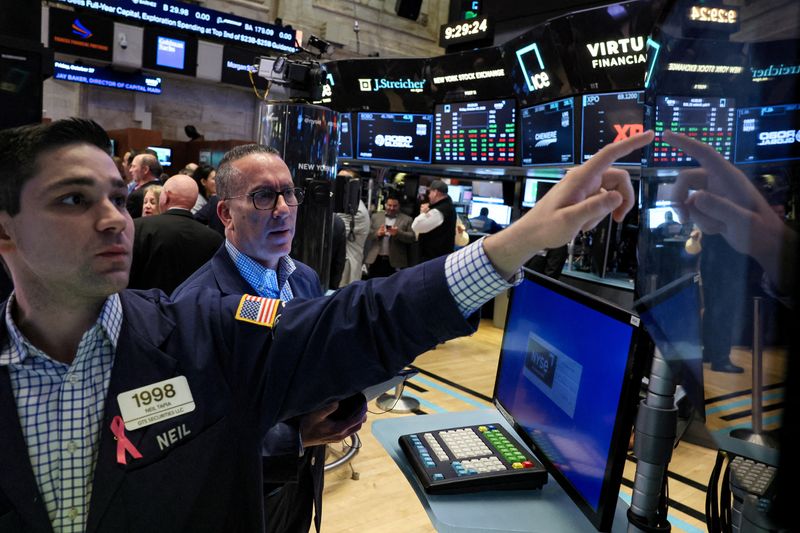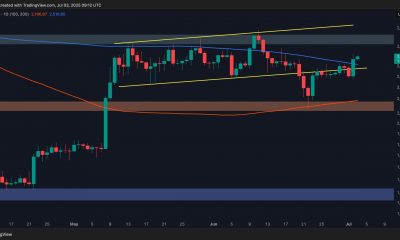Economy
S&P 500 hits 2023 closing high as Powell strengthens peak rate bets


© Reuters. FILE PHOTO: Traders work on the floor at the New York Stock Exchange (NYSE) in New York City, U.S., October 27, 2023. REUTERS/Brendan McDermid/File Photo
By Stephen Culp
NEW YORK (Reuters) -U.S. stocks rallied and the S&P registered its highest close of the year on Friday, starting December on an upbeat note as remarks from Federal Reserve Chair Jerome Powell bolstered the view that key policy rates have peaked.
All three major U.S. stock indexes advanced, with economically sensitive transports and smallcaps enjoying the most robust gains.
“Those sectors – the cyclicals – they’re the most hated parts of the market year-to-date, (and they) are the parts that are leading,” said Scott Ladner, chief investment officer at Horizon Investments in Charlotte, North Carolina. “On the first day of December, when everybody’s looking for a Santa Claus rally, it probably carries a little bit of extra weight.”
“If December starts out strong, it’s going to make folks jump on board and chase this rally,” Ladner added.
All three indexes notched their fifth consecutive weekly percentage gains. On Thursday, they wrapped up a banner month in which the and the Nasdaq registered their biggest one-month percentage gains since July 2022, and the Dow closed at its highest level since January 2022.
In prepared remarks, Powell acknowledged the central bank’s need to “move forward carefully” amid signs of economic softening, as the risks of over- and under-tightening its monetary policy are becoming more balanced.
“Earlier in the week, (Fed Governor Christopher) Waller, one of the Fed’s biggest hawks, said as inflation decreases, we’re going to drop rates,” Ladner said. “The market thought that Powell would push against those remarks, and he didn’t.
“(Powell) is setting the market up for rate cuts next year.”
Data released on Friday showed U.S. manufacturing continues to contract as factories contend with decreasing new orders, falling inventories and labor pressures.
The rose 294.61 points, or 0.82%, to 36,245.5, the S&P 500 gained 26.83 points, or 0.59%, at 4,594.63 and the added 78.81 points, or 0.55%, at 14,305.03.
Among the 11 major sectors of the S&P 500, real estate was the biggest percentage gainer, while communication services was the sole decliner.
Pfizer (NYSE:) slid 5.1% as the drugmaker dropped plans to advance a twice-daily version of oral weight-loss drug danuglipron into late-stage studies, delaying its entry into the lucrative market.
U.S.-listed shares of Alibaba (NYSE:) slipped 1.2% following Morgan Stanley’s downgrade of the e-commerce giant’s stock.
Marvell (NASDAQ:) Technology shed 5.3% after the chipmaker’s fourth-quarter revenue forecast fell short of Street estimates.
Ulta Beauty (NASDAQ:) surged 10.8 after the cosmetics retailer raised the lower end of its annual net sales forecast and named Paula Oyibo its new chief financial officer.
Paramount Global jumped 9.8% following a report the media company and Apple (NASDAQ:) have discussed bundling their streaming services at a discount.
Advancing issues outnumbered decliners on the NYSE by a 5.93-to-1 ratio; on Nasdaq, a 3.32-to-1 ratio favored advancers.
The S&P 500 posted 59 new 52-week highs and one new low; the Nasdaq Composite recorded 106 new highs and 82 new lows.
Volume on U.S. exchanges was 12.34 billion shares, compared with the 10.58 billion average for the full session over the last 20 trading days.
Economy
Russian central bank says it needs months to make sure CPI falling before rate cuts -RBC


© Reuters. Russian Central Bank Governor Elvira Nabiullina attends a news conference in Moscow, Russia June 14, 2019. REUTERS/Shamil Zhumatov/File Photo
MOSCOW (Reuters) – Russia’s central bank will need two to three months to make sure that inflation is steadily declining before taking any decision on interest rate cuts, the bank’s governor Elvira Nabiullina told RBC media on Sunday.
The central bank raised its key interest rate by 100 basis points to 16% earlier in December, hiking for the fifth consecutive meeting in response to stubborn inflation, and suggested that its tightening cycle was nearly over.
Nabiullina said it was not yet clear when exactly the regulator would start cutting rates, however.
“We really need to make sure that inflation is steadily decreasing, that these are not one-off factors that can affect the rate of price growth in a particular month,” she said.
Nabiullina said the bank was taking into account a wide range of indicators but primarily those that “characterize the stability of inflation”.
“This will take two or three months or more – it depends on how much the wide range of indicators that characterize sustainable inflation declines,” she said.
The bank will next convene to set its benchmark rate on Feb. 16.
The governor also said the bank should have started monetary policy tightening earlier than in July, when it embarked on the rate-hiking cycle.
Economy
China identifies second set of projects in $140 billion spending plan


© Reuters. FILE PHOTO: Workers walk past an under-construction area with completed office towers in the background, in Shenzhen’s Qianhai new district, Guangdong province, China August 25, 2023. REUTERS/David Kirton/File Photo
SHANGHAI (Reuters) – China’s top planning body said on Saturday it had identified a second batch of public investment projects, including flood control and disaster relief programmes, under a bond issuance and investment plan announced in October to boost the economy.
With the latest tranche, China has now earmarked more than 800 billion yuan of its 1 trillion yuan ($140 billion) in additional government bond issuance in the fourth quarter, as it focuses on fiscal steps to shore up the flagging economy.
The National Development and Reform Commission (NDRC) said in a statement on Saturday it had identified 9,600 projects with planned investment of more than 560 billion yuan.
China’s economy, the world’s second largest, is struggling to regain its footing post-COVID-19 as policymakers grapple with tepid consumer demand, weak exports, falling foreign investment and a deepening real estate crisis.
The 1 trillion yuan in additional bond issuance will widen China’s 2023 budget deficit ratio to around 3.8 percent from 3 percent, the state-run Xinhua news agency has said.
“Construction of the projects will improve China’s flood control system, emergency response mechanism and disaster relief capabilities, and better protect people’s lives and property, so it is very significant,” the NDRC said.
The agency said it will coordinate with other government bodies to make sure that funds are allocated speedily for investment and that high standards of quality are maintained in project construction.
($1 = 7.1315 renminbi)
Economy
Russian central bank says it needs months to make sure CPI falling before rate cuts -RBC


© Reuters. Russian Central Bank Governor Elvira Nabiullina attends a news conference in Moscow, Russia June 14, 2019. REUTERS/Shamil Zhumatov/File Photo
MOSCOW (Reuters) – Russia’s central bank will need two to three months to make sure that inflation is steadily declining before taking any decision on interest rate cuts, the bank’s governor Elvira Nabiullina told RBC media on Sunday.
The central bank raised its key interest rate by 100 basis points to 16% earlier in December, hiking for the fifth consecutive meeting in response to stubborn inflation, and suggested that its tightening cycle was nearly over.
Nabiullina said it was not yet clear when exactly the regulator would start cutting rates, however.
“We really need to make sure that inflation is steadily decreasing, that these are not one-off factors that can affect the rate of price growth in a particular month,” she said.
Nabiullina said the bank was taking into account a wide range of indicators but primarily those that “characterize the stability of inflation”.
“This will take two or three months or more – it depends on how much the wide range of indicators that characterize sustainable inflation declines,” she said.
The bank will next convene to set its benchmark rate on Feb. 16.
The governor also said the bank should have started monetary policy tightening earlier than in July, when it embarked on the rate-hiking cycle.

 Forex3 years ago
Forex3 years agoForex Today: the dollar is gaining strength amid gloomy sentiment at the start of the Fed’s week

 Forex3 years ago
Forex3 years agoUnbiased review of Pocket Option broker

 Forex3 years ago
Forex3 years agoDollar to pound sterling exchange rate today: Pound plummeted to its lowest since 1985

 Forex3 years ago
Forex3 years agoHow is the Australian dollar doing today?

 Cryptocurrency3 years ago
Cryptocurrency3 years agoWhat happened in the crypto market – current events today

 World3 years ago
World3 years agoWhy are modern video games an art form?

 Commodities3 years ago
Commodities3 years agoCopper continues to fall in price on expectations of lower demand in China

 Economy3 years ago
Economy3 years agoCrude oil tankers double in price due to EU anti-Russian sanctions





























